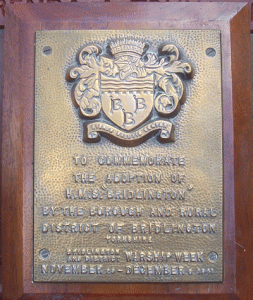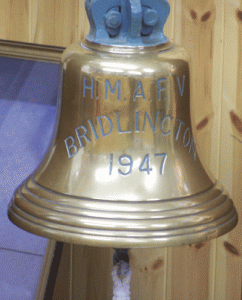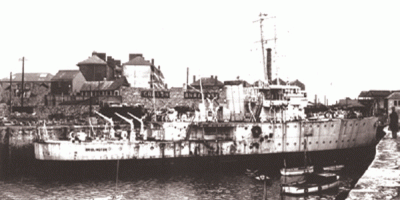

Royal Naval Association
Bridlington Branch
HMS Bridlington
By Local Historian and and with thanks to Author Mike Wilson

Residents of Bridlington first heard of a vessel being named after their town in an announcement in the Bridlington Chronicle of 28th July 1939.
A small paragraph read: "Amongst the names which have been approved for certain ships of Britain's 1939 naval construction programme figures that of HMS Bridlington." She was to be a Bangor class minesweeper.
Bridlington Free Press said on 2nd November 1940 that "at the Town Council meeting on Wednesday night it was announced by Alderman H. Harker that intimation had been received that one of His Majesty's ships had been named HMS Bridlington."
The piece added that "when happier days came along it was hoped that the ship would visit Bridlington Bay."
In February 1941 the paper said that HMS Bridlington had thanked the local WRVS for a parcel of woollens sent for the 60 men on board.
October of that year saw Bridlington's Warship Week, in which HMS Kittiwake was adopted by the town. It was hoped to raise sufficient money during that week to buy a ship – in Bridlington's case, the Kittiwake – and the target was £100,000.
At the end of the year, the local papers declared that £12 per head of population had been raised by Warship Week, providing a total of £293,762.
Plans to adopt the Kittiwake had now been changed and the town was able to adopt HMS Bridlington. The Admiralty said they would provide plaques from HMS Bridlington, which would be given to the Corporation.
Commemorative Plaque

The Chronicle said during its coverage of this event: "HMS Bridlington is the one selected as suitable for the town whose name it bears. She is a super minesweeper, and though not a fighting ship, she fills a vital role in winning the war, by helping to keep the seas clear of the infernal devices which are sown in the waters surrounding our island to prevent the mercantile marine fulfilling their lawful occupations, and the important mission with which they are entrusted in seeing to it that the inhabitants of this land are not deprived of the necessaries of life which is one of the principal aims of our enemy."
By September 1942, the adoption of the vessel was completed, when an exchange of plaques took place between the ship and the Corporation and Rural District of Bridlington.
The captain of HMS Bridlington sent a message: "It has been a big disappointment not being able to bring the ship, and not even to be present myself at your ceremony that day, but pressure of work is too great to allow us of even a day off."
Throughout the war the papers told of packages being sent to the vessel and that the thanks of the crew were returned.
In 1946, HMS Bridlington was transferred to the RAF, when her title became His Majesty's Air Force Vessel Bridington. Six months later she was manned by the RAF. Sqn.Ldr. George Coates, DSC, took over as Commanding Officer, when the ship was "handed over" in Chatham.
The Royal Navy had handed back to Bridlington the plaques they had formerly received, but the Council decided to return them to the vessel in her new guise.
In the Council minutes for 18th March 1949, it was resolved that the crew of HMAFV Bridlington should be granted free admission to the Parade and the Spa, when the vessel visited the town between 14th and 19th April that year. A later Council minute stated that the cost to the town for the presentations to the officers and other ranks of HMAFV Bridlington would be £80.
The local paper announced that the Mayor (Cllr F. F. Millner) confirmed the re-adoption of the ship by the town, and he presented several souvenirs to the ship's captain. Sqn.Ldr. Cooper presented the Mayor with a replica of the ship's badge and two silver-plated salinometers.
HMS Bridlington was also in the bay and open to visitors during the Coronation of the Carnival Queen during August's carnival week.
In September, the vessel was on the Thames at Tower Pier, where she provided accommodation for the crew of a Sunderland flying boat.
HMS Bridlington went into reserve at West Hartlepool and prepared for service under an RAF ensign. All her wartime weaponry and accessories were removed and she was painted grey and white.
Her complement as an RAF vessel was 44 men and four officers. This was about half the size of the Royal Navy crews.
Her first duties as an Air Force Vessel saw her join 18 Group, at RAF Pitreavie, near Rosyth. She was then attached to HMS Sea Eagle at Londonderry.
In October 1955, still named HMS Bridlington, she left England to sail to Gan, in the Indian Ocean, carrying surveying equipment and personnel. These were used to create a landing strip on the island. She sailed regularly beween the island and Colombo, 415 miles distant, giving the ship and its crew a large workload.
On completion of the repair of an old wartime runway, Bridlington's task of ferrying was obsolete when Sunderland flying boats and Bristol Freighters of the Royal New Zealand Air Force took over this task. They flew from the airfield at Katunayake in Ceylon.
The Bridlington returned to the UK, arriving at Plymouth on 26th April 1956.
On 28th April 1958, Sqn.Ldr. Loughnan handed back to the town the ship's bell and name plaque of HMAFV Bridlington. The Mayor, Ald. Mary Pagett, presented a silver salver and a cup as trophies for RAF Coastal Command Dinghy Sailing Championships.
The vessel was scrapped in Plymouth on 6th May 1958.
* * *
HMS Bridlington was a Bangor class minesweeper, number J65. She was one of four diesel-engined vessels. She was laid down on 11th September 1939, launched 29th February 1940 and commissioned on 28th September 1940.
The builder was William Denny & Brothers (Dumbarton, Scotland), with machinery built by Harland & Wolff Ltd (Govan, Scotland). She had 2000hp diesel motors driving reciprocating engines (VTE) and geared turbines on two shafts. Her maximum speed was 16 knots, and she weighed 590 tons.
HMS Bridlington was among the first four of her class, the others being Bangor, Blackpool and Bridport).
Her displacement was 672 BRT, she was 180 feet long, had a breadth of 28ft, a depth of 15ft 6in, and a draft of 8ft 3in (10ft 6in fully loaded). She had a complement of 60 men.
Her armament included one 3in. anti-aircraft gun, and varied anti-aircraft armament.
Two captains recorded are Lt. Charles Wickham Malins, R.N., who commanded her from 12th July 1940, and Lt. Peter John Baye, from 24th February 1942 until August 1942. On 2nd October, 1941, HMS Bridlington sailed from Harwich and joined HMS Eastbourne in the English Channel for minesweeping duties.
During the period December 1942 to January 1943, Petty Officer Arthur Ernest Brown was mentioned in despatches for "bravery and skill while employed on the hazardous duties of keeping the seas clear of mines."
HMS Bridlington played her part in Operation Overlord, the D-Day landings. As one of nine ships of the 9th minesweeping flotilla, she sailed from the Solent at 12.55 hours on 5th June 1944 heading for Juno beach.
In St Clement Danes Church, in central London, this plaque engraved in the floor of the central aisle commemorates HMAFV Bridlington.
All that is left of HMAFV Bridlington are the ship's bell (below), nameplate (above), two name plaques, two tankards and a notice of the ship's service. The original plaque showing the adoption by HMS Bridlington by the town also exists. These items have been transferred on loan by the East Riding of Yorkshire Council to Bridlington Harbour Heritage Museum for display each season.
Information taken from www.bridlington.net/bridlington-history/hms-bridlington/


